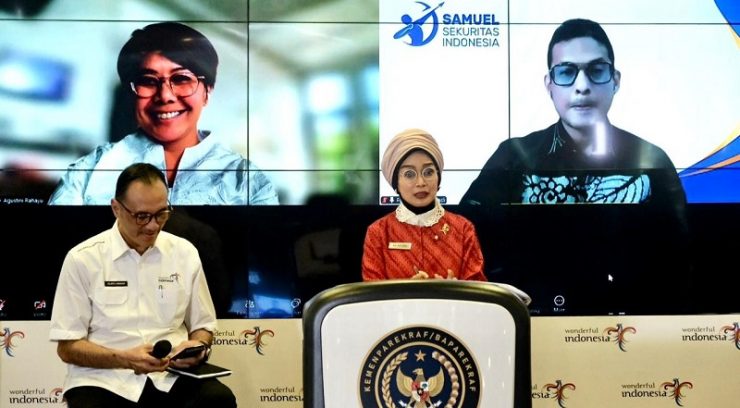THE INDONESIA’S Ministry of Tourism and Creative Economy is encouraging the strengthening of stock indices in the country’s tourism and creative economy sectors by establishing a special index for issuers in the tourism and creative economy sectors. It is hoped that the formation of this special issuer will attract larger or retail investments in the future.
According to Ministry’s Senior Expert Staff, Nia Niscaya in “The Weekly Brief with Sandi Uno”, which was held in a hybrid at the Sapta Pesona Building, Jakarta, Monday (07/15), 2024, explained the efforts to form tourism and creative issuers written in the signing of the MoU between the Tourism and Creative Economy Ministry and Samuel Sekuritas Indonesia on July 10, 2024.
This time at Weekly Brief, the discussion focused on a sub-sector of the creative economy, namely film industry issuers. “The potential of issuers in the film industry is very large. As is known, the film industry still has a lot of room for growth,” Nia said.
Some of the indicators are the increasing number of moviegoers. The number of moviegoers in Indonesia reached 40 million in the first semester of this year. Potentially surpassing the record of 55 million viewers in 2022. There is also the development of the digital economy, which allows movies that are regularly shown in cinemas to be shown later on streaming platforms.
“Of course, with the increasing attention to the tourism and creative sector, which is listed on the Indonesia Stock Exchange, we hope that it will have an increasing impact on the national economy,” Nia stated.
Meanwhile, the Director of Strategic Studies at the Tourism Ministry, Agustini Rahayu, explained that the collaboration with Samuel Sekuritas aims to enable the Ministry of Tourism and Creative Economy to gain valuable insights, decision-making support and access to the latest information on issuers in the tourism and creative sector in order to develop and implement more effective strategies to advance the tourism and creative industries.
Furthermore, Ayu explained that this MoU does not only focus on the film sector, but on all sub-sectors in the tourism and creative industries. There are three main things discussed in the MoU, namely the formation of an index of tourism and creative economy issuers, the analysis and discussion of trends in creative and creative economy issuers, and the discussion of opportunities for creative and creative economy issuers on the Indonesia Stock Exchange.
Likewise, the Director of Investment Management at the Tourism Ministry, Zulkifli Harahap, added that after the MoU, the Ministry of Tourism and Creative Economy together with Samuel Sekuritas classified the business types. Where the issuer mapping was carried out in all 13 tourism business sectors and 17 creative economy subsectors.
“There are 33 issuers that have been classified, so next we will create an index so that the issuers that have been mapped are classified according to their type. Finally, it will be finalized. For this reason, we continue to encourage and support the tourism and creative economy sector so that it can fly on the Indonesia Stock Exchange,” Zulkifli explained.
Also at same event, Samuel Sekuritas Indonesia Senior Economist, Fitrah Faisal Hastiadi, said that if you look at the cycle, the tourism and creative economy sector usually falls into the category of cyclical issuers. This means that this sector is then able to surf with the potential for economic growth.
“We will see the economic trend getting better or worse every year based on the performance of one of the issuers in the cyclical zone,” Fitrah added.
The Indonesia Stock Exchange (BEI) recently introduced a new category called IDX Cyclical 30. This category is indices that are cyclically very high and serve as a patrol for other issuers. One of the things that falls under this category is the film subsector.
“It’s very strategic when the Ministry of Tourism and Creative Economy looks at economic performance, one of which is the performance of issuers. And when we look at the behavior, this sector is actually a sector that can contribute to economic growth in the future. It is not only a leading indicator, but it is also a source of growth and “it has even become a sector that can compensate when the economy is down,” Fitrah concluded. [traveltext.id]
















